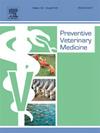Effects of short-term climatic conditions on the risk of bovine respiratory disease in preweaned calves on California dairies
IF 2.4
2区 农林科学
Q1 VETERINARY SCIENCES
引用次数: 0
Abstract
Bovine Respiratory Disease (BRD) significantly impacts dairy calf health and economics, yet the relationship between short-term weather patterns and BRD risk remains poorly understood, particularly across different seasons and regions in California. We explored the effects of short-term climatic conditions on BRD in preweaned dairy calves using machine learning approaches. Data from 11,470 calves across five California dairy farms were analyzed using tree-based models to investigate associations between BRD status and climate variables, including temperature, humidity, and temperature-humidity index (THI) over one to three days prior to diagnosis. The gradient boosting model achieved the best performance with an area under the receiver operating characteristic curve of 0.720 (sensitivity: 0.71, specificity: 0.73). Maximum relative humidity two days prior and maximum THI three days before BRD diagnosis were the most important short-term climatic predictors of BRD risk along with the region of California and calf age. The analysis indicated that summer conditions in Southern California were associated with higher BRD risk 48 h post-exposure; maximum THI below 75 in winter increased BRD risk 72 h post-exposure across all regions; and calves aged 20–30 days in Southern California showed higher BRD risk compared to Northern California across all seasons. These findings provide novel insights into how short-term weather patterns influence BRD development, potentially supporting the development of region-specific prevention strategies.
短期气候条件对加州奶牛场未断奶犊牛呼吸道疾病风险的影响
牛呼吸道疾病(BRD)显著影响奶牛的健康和经济,但短期天气模式与BRD风险之间的关系仍然知之甚少,特别是在加利福尼亚州的不同季节和地区。我们利用机器学习方法探讨了短期气候条件对断奶前犊牛BRD的影响。研究人员使用基于树木的模型分析了加州5个奶牛场11,470头小牛的数据,以调查BRD状态与气候变量(包括诊断前1至3天的温度、湿度和温湿度指数(THI))之间的关系。梯度增强模型在受试者工作特征曲线下的面积为0.720(灵敏度为0.71,特异度为0.73),达到最佳效果。最大相对湿度在BRD诊断前两天和最大THI在BRD诊断前三天是BRD风险最重要的短期气候预测因子,以及加利福尼亚地区和小牛年龄。分析表明,南加州的夏季条件与暴露后较高的BRD风险48 h相关;冬季最大THI低于75时,所有地区暴露后BRD风险增加72 h;在所有季节,南加州20-30天的小牛都比北加州有更高的BRD风险。这些发现为短期天气模式如何影响复兴开发银行的发展提供了新的见解,可能支持制定针对特定区域的预防策略。
本文章由计算机程序翻译,如有差异,请以英文原文为准。
求助全文
约1分钟内获得全文
求助全文
来源期刊

Preventive veterinary medicine
农林科学-兽医学
CiteScore
5.60
自引率
7.70%
发文量
184
审稿时长
3 months
期刊介绍:
Preventive Veterinary Medicine is one of the leading international resources for scientific reports on animal health programs and preventive veterinary medicine. The journal follows the guidelines for standardizing and strengthening the reporting of biomedical research which are available from the CONSORT, MOOSE, PRISMA, REFLECT, STARD, and STROBE statements. The journal focuses on:
Epidemiology of health events relevant to domestic and wild animals;
Economic impacts of epidemic and endemic animal and zoonotic diseases;
Latest methods and approaches in veterinary epidemiology;
Disease and infection control or eradication measures;
The "One Health" concept and the relationships between veterinary medicine, human health, animal-production systems, and the environment;
Development of new techniques in surveillance systems and diagnosis;
Evaluation and control of diseases in animal populations.
 求助内容:
求助内容: 应助结果提醒方式:
应助结果提醒方式:


